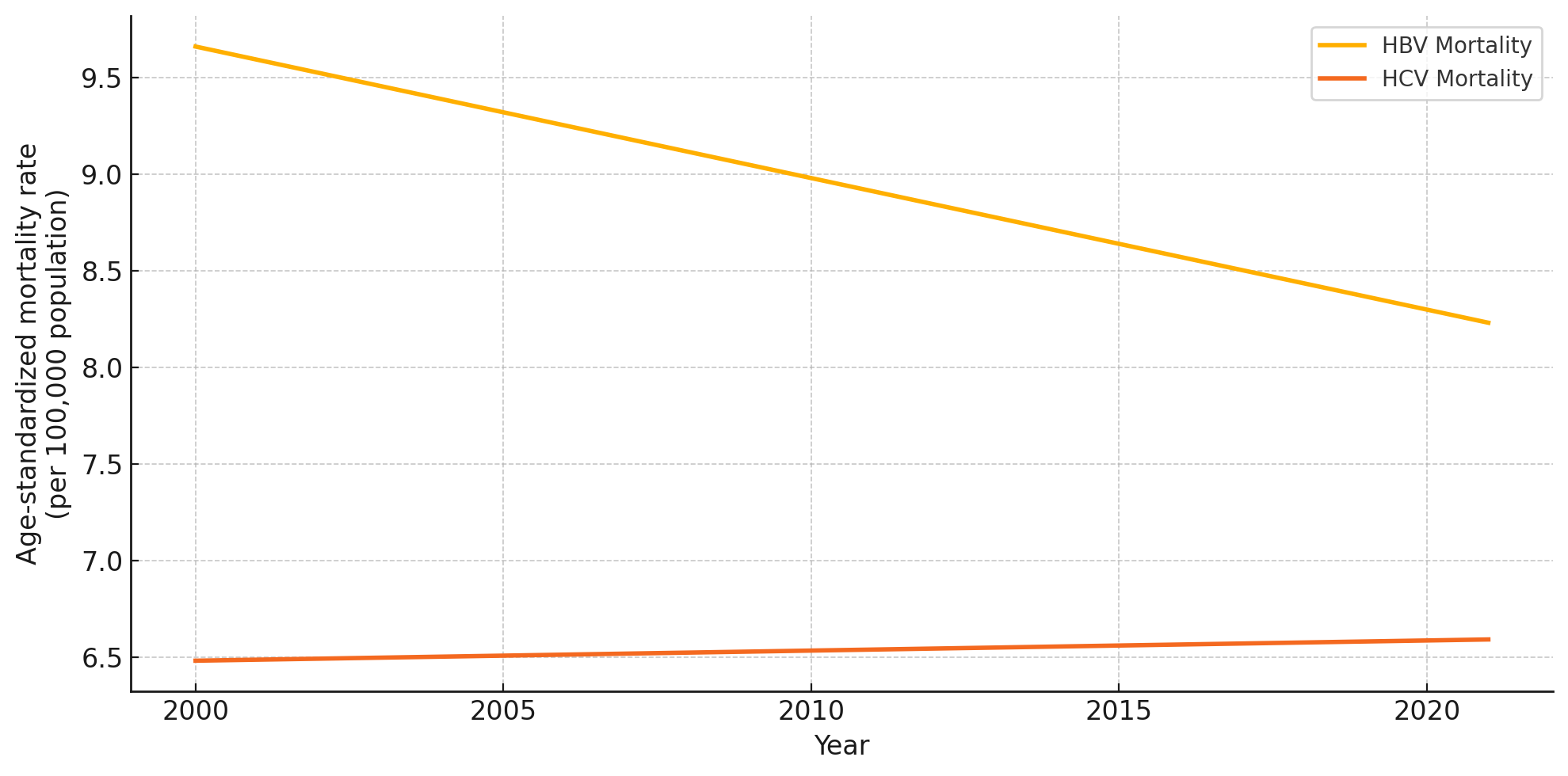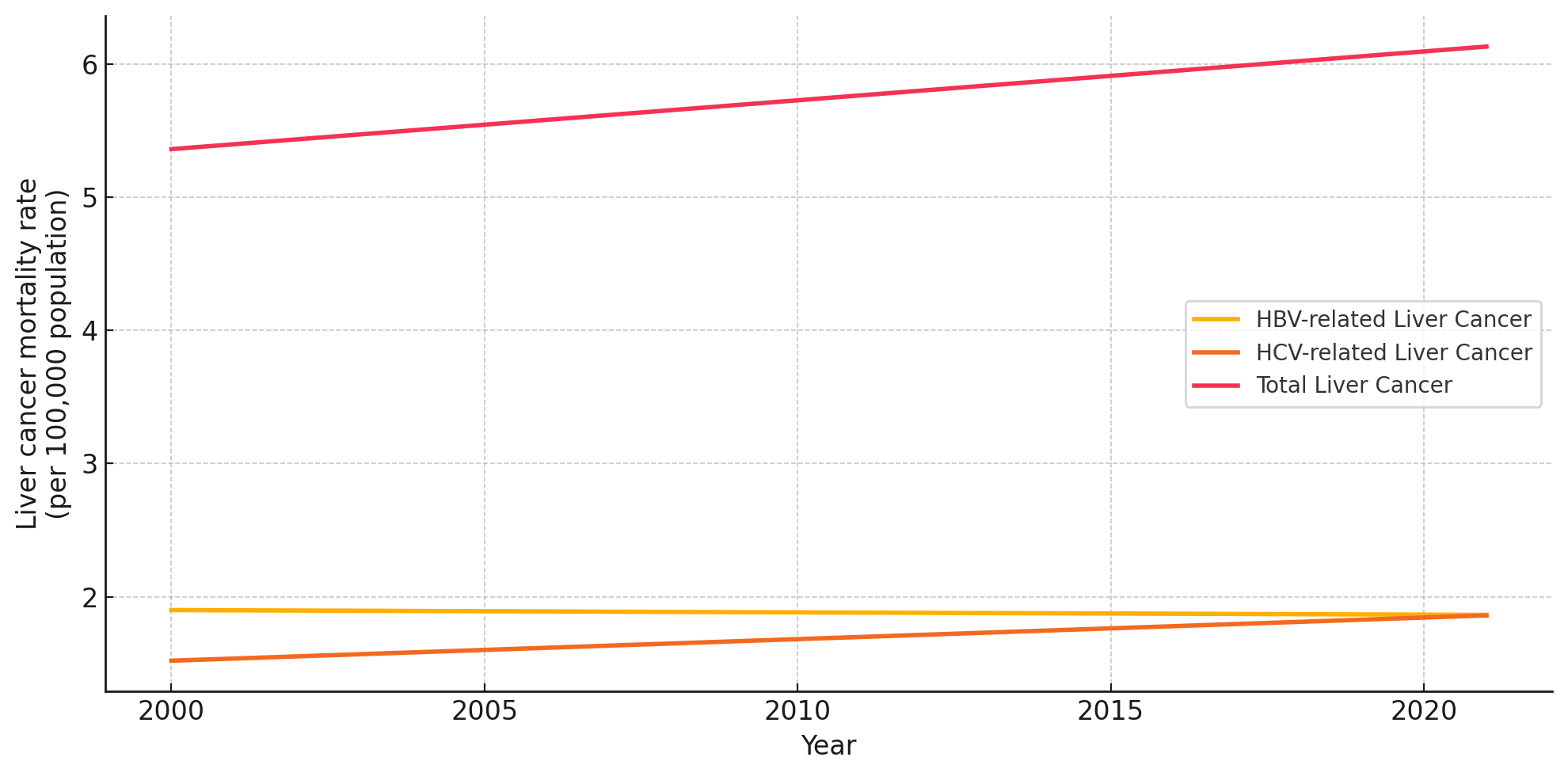Monday Poster Session
Category: Liver
P3622 - Divergent Trends in Global Hepatitis B, C-Related Mortality and Liver Cancer Burden: Evidence From 2 Decades of Global Burden of Disease Data (2000-2021)
Monday, October 27, 2025
10:30 AM - 4:00 PM PDT
Location: Exhibit Hall

George S. Blewusi, MD (he/him/his)
Johns Hopkins Bloomberg School of Public Health
Baltimore, MD
Presenting Author(s)
John K. Appiah, MD1, George S. Blewusi, MD2, Richeal Asante, MD3, Evans Donneyong, MD4, Emmanuel Asare, 5
1Geisinger Wyoming Valley Medical Center, Wilkes-Barre, PA; 2Johns Hopkins Bloomberg School of Public Health, Baltimore, MD; 3Geisinger Wyoming Valley Medical Center, Kingston, PA; 4Tamale Teaching Hospital, Tamale, Northern, Ghana; 5Montefiore hospital, Bronx, NY
Introduction: Viral hepatitis remains a leading cause of global mortality, with hepatitis B virus (HBV) and hepatitis C virus (HCV) contributing significantly to the burden of liver disease and hepatocellular carcinoma worldwide. This study aimed to analyze global trends in HBV and HCV-related mortality, including liver cancer burden, over two decades to inform elimination strategies and resource allocation.
Methods: Global age-standardized mortality rates per 100,000 population were extracted from the Global Burden of Disease (GBD) 2021 dataset for the years 2000 to 2021. Causes included total deaths related to HBV and HCV, as well as liver cancer specifically attributable to each virus. Estimates included all ages and both sexes.
Results: Over the 22-year study period, hepatitis B-related mortality declined from 9.66 to 8.23 per 100,000 population (14.9% decrease), while hepatitis C-related mortality remained relatively stable, increasing slightly from 6.48 to 6.59 per 100,000 population (1.7% increase). Hepatitis B consistently maintained higher mortality rates, with a 1.25:1 ratio compared to hepatitis C in 2021. Overall liver cancer mortality increased by 14.4% from 5.36 to 6.13 per 100,000 population. Notably, while HBV-related liver cancer mortality showed a modest decline (-1.9%), HCV-related liver cancer mortality increased substantially by 22.1% from 1.52 to 1.86 per 100,000 population.
Discussion: Despite global prevention efforts, viral hepatitis remains a significant public health challenge. The decline in hepatitis B mortality likely reflects vaccination program impact, while persistent hepatitis C mortality, particularly the 22% increase in HCV-related liver cancer deaths, highlights ongoing treatment gaps. These findings support continued investment in comprehensive viral hepatitis elimination programs with enhanced hepatitis C treatment expansion and liver cancer screening.

Figure: Figure 1. Trends in global age-standardized mortality rates for hepatitis B virus (HBV) and hepatitis C virus (HCV) from 2000 to 2021. HBV-related mortality declined by 14.9%, while HCV-related mortality remained relatively stable, increasing slightly by 1.7%.

Figure: Figure 2. Trends in global liver cancer mortality attributable to HBV, HCV, and overall causes from 2000 to 2021. HBV-related liver cancer mortality declined by 1.9%, HCV-related liver cancer mortality increased by 22.1%, and overall liver cancer mortality rose by 14.4%.
Disclosures:
John Appiah indicated no relevant financial relationships.
George Blewusi indicated no relevant financial relationships.
Richeal Asante indicated no relevant financial relationships.
Evans Donneyong indicated no relevant financial relationships.
Emmanuel Asare indicated no relevant financial relationships.
John K. Appiah, MD1, George S. Blewusi, MD2, Richeal Asante, MD3, Evans Donneyong, MD4, Emmanuel Asare, 5. P3622 - Divergent Trends in Global Hepatitis B, C-Related Mortality and Liver Cancer Burden: Evidence From 2 Decades of Global Burden of Disease Data (2000-2021), ACG 2025 Annual Scientific Meeting Abstracts. Phoenix, AZ: American College of Gastroenterology.
1Geisinger Wyoming Valley Medical Center, Wilkes-Barre, PA; 2Johns Hopkins Bloomberg School of Public Health, Baltimore, MD; 3Geisinger Wyoming Valley Medical Center, Kingston, PA; 4Tamale Teaching Hospital, Tamale, Northern, Ghana; 5Montefiore hospital, Bronx, NY
Introduction: Viral hepatitis remains a leading cause of global mortality, with hepatitis B virus (HBV) and hepatitis C virus (HCV) contributing significantly to the burden of liver disease and hepatocellular carcinoma worldwide. This study aimed to analyze global trends in HBV and HCV-related mortality, including liver cancer burden, over two decades to inform elimination strategies and resource allocation.
Methods: Global age-standardized mortality rates per 100,000 population were extracted from the Global Burden of Disease (GBD) 2021 dataset for the years 2000 to 2021. Causes included total deaths related to HBV and HCV, as well as liver cancer specifically attributable to each virus. Estimates included all ages and both sexes.
Results: Over the 22-year study period, hepatitis B-related mortality declined from 9.66 to 8.23 per 100,000 population (14.9% decrease), while hepatitis C-related mortality remained relatively stable, increasing slightly from 6.48 to 6.59 per 100,000 population (1.7% increase). Hepatitis B consistently maintained higher mortality rates, with a 1.25:1 ratio compared to hepatitis C in 2021. Overall liver cancer mortality increased by 14.4% from 5.36 to 6.13 per 100,000 population. Notably, while HBV-related liver cancer mortality showed a modest decline (-1.9%), HCV-related liver cancer mortality increased substantially by 22.1% from 1.52 to 1.86 per 100,000 population.
Discussion: Despite global prevention efforts, viral hepatitis remains a significant public health challenge. The decline in hepatitis B mortality likely reflects vaccination program impact, while persistent hepatitis C mortality, particularly the 22% increase in HCV-related liver cancer deaths, highlights ongoing treatment gaps. These findings support continued investment in comprehensive viral hepatitis elimination programs with enhanced hepatitis C treatment expansion and liver cancer screening.

Figure: Figure 1. Trends in global age-standardized mortality rates for hepatitis B virus (HBV) and hepatitis C virus (HCV) from 2000 to 2021. HBV-related mortality declined by 14.9%, while HCV-related mortality remained relatively stable, increasing slightly by 1.7%.

Figure: Figure 2. Trends in global liver cancer mortality attributable to HBV, HCV, and overall causes from 2000 to 2021. HBV-related liver cancer mortality declined by 1.9%, HCV-related liver cancer mortality increased by 22.1%, and overall liver cancer mortality rose by 14.4%.
Disclosures:
John Appiah indicated no relevant financial relationships.
George Blewusi indicated no relevant financial relationships.
Richeal Asante indicated no relevant financial relationships.
Evans Donneyong indicated no relevant financial relationships.
Emmanuel Asare indicated no relevant financial relationships.
John K. Appiah, MD1, George S. Blewusi, MD2, Richeal Asante, MD3, Evans Donneyong, MD4, Emmanuel Asare, 5. P3622 - Divergent Trends in Global Hepatitis B, C-Related Mortality and Liver Cancer Burden: Evidence From 2 Decades of Global Burden of Disease Data (2000-2021), ACG 2025 Annual Scientific Meeting Abstracts. Phoenix, AZ: American College of Gastroenterology.
